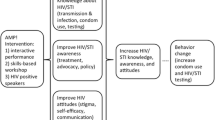Abstract
The purpose of this study was to test the effects of an AIDS education program on the knowledge, attitudes and practices of low income black and Latina women. A pretest-posttest nonequivalent control group design was used with a 2–3 month retest of the experimental group. The sample consisted of 506 experimental and 206 control group women who were clients of the Public Health Foundation's Nutrition Program for Women, Infants and Children in Los Angeles County. The program included a slide-tape presentation, and educational and resource brochures in English and Spanish. Knowledge, attitudes, and sexual and drug use practices were measured using a structured questionnaire that was developed in English and Spanish. Content validity and reliability of the questionnaire were established. A 2-way repeated measures ANOVA examined differences in pretest-posttest knowledge, attitudes, and practices for experimental and control groups and for both racial/ethnic groups. The experimental group made significant gains over the control group on pretest-posttest measures of knowledge and attitudes. Both experimental and control groups made significant changes in practice. Changes in knowledge were retained on retest; changes in practices came close to significance on retest. Blacks and Latinas differed on pretest knowledge and attitudes but not practices. Blacks had more knowledge and positive attitudes on pretest. However, posttest improvements for both knowledge and attitudes were greater in Latinas than in blacks. A multiple regression analysis revealed that the best predictors of knowledge, attitudes and practices were racial/ethnic group, education, and religion. It is concluded that a didactic audio visual program can positively affect the knowledge and possibly the practices of participants and that these are retained over time but that changes in attitudes will take further efforts.
Similar content being viewed by others
References
Centers for Disease Control. Acquired Immunodeficiency Syndrome (AIDS) Among Blacks & Hispanics—United States.MMWR 1986; 655–658, 663–666.
Selik RM, Kennth GC, Pappioanou M. Distribution of AIDS Cases by Racial/Ethnic Group and Exposure Category, United States, June 1, 1981–July 4, 1988.MMWR, CDC Surveill Summ 1988;37(55-3):1–10.
Houston-Hamilton A. A Constant Increase: AIDS in Ethnic Communities.Focus 1986;1(1):1–2.
Rogers MR, Williams WW. AIDS in Blacks and Hispanics: Implications for Prevention.Issues in Science and Technology 1987;899–94.
Centers for Disease Control. United States AIDS Program.AIDS Weekly Surveillance Report, Atlanta, GA March, 1989.
Flaskerud JH. Prevention of AIDS in Blacks and Hispanics: Nursing Implications.J Community Health Nurs 1988;5(1):59–58.
Nyamathi AM, Flaskerud JH. Risk Factors and HIV Infection. In: Flaskerud JH (ed): AIDS/HIV Infection, A Reference Guide for Nursing Professionals. Philadelphia 1989, W.B. Saunders.
Selik RM, Kenneth GC, Pappioanou M. Racial/Ethnic Differences in the Risk of AIDS in the United States.Am J Public Health 1988;78:1539–1545.
Faltz BG, Madover S. AIDS and Substance Abuse: Issues for Health Care Providers.Focus 1986;I:1–2.
Kleinman S, Sohner S, Wilke D. Analysis of HIV Seropositive Donors: Donor Referral Policies and Infection Prevalence. Paper presented at the American Association of Blood Banks Annual Meeting, San Francisco, CA November, 1986.
Bakeman R, Lamb JR, Jackson RE, Smith DW. AIDS Risk-Group Profiles in Whites and Members of Minority Groups.N Engl J Med 1986;315:191–192.
Morales ES. AIDS Education in the Latino Community. Paper presented at the AIDS/ARC '87 Update Conference, San Francisco, CA July, 1987.
Cleary PD, Singer E, Rogers TF, et al. Sociodemographic and Behavioral Characteristics of HIV Antibody—Positive Blood Donors.Am J Public Health 1988;78:953–957.
DiClemente RJ, Cherrie BB, Morales ES. Minorities and AIDS: Knowledge, Attitudes and Misconceptions Among Black and Latino Adolescents.Am J Public Health 1988;78(1):55–57.
Mays VM, Cochran SD. Issues in the Perception of AIDS Risk and Risk Reduction Activities by Black and Hispanic/Latina Women.Am Psychol 1988;43:949–956.
Peterson JL, Marin, G. Issues in the Prevention of AIDS Among Black and Hispanic Men.Am Psychol 1988;43:871–877.
Mays VM, Cochran SD. Acquired Immunodeficiency Syndrome and Black Americans: Special Psychosocial Issues.Public Health Rep 1987;102(2):224–231.
California Department of Health Services, Office of AIDS.California Morbidity Report, Sacramento, CA September, 1986.
Williams LS. AIDS Risk Reduction: A Community Health Education Intervention for Minority High Risk Group Members.Health Educ Q 1986;13(4):407–421.
Staples R. The Black American Family. In: Mindel CH, Habenstein RW (eds): Ethnic Families in America. New York 1981, Elsevier; 217–244.
Fitzpatrick JP. The Puerto Rican Family. In: Mindel CH, Habenstein RW (eds): Ethnic Families in America. New York 1981, Elsevier; 189–214.
Alvirez D, Bean FD, Williams D. The Mexican American Family. In: Mindel CH, Habenstein RW (eds): Ethnic Families in American. New York 1981, Elsevier; 269–292.
Campbell DT, Stanley JC.Experimental and Quasi-Experimental Designs for Research. Chicago 1963, McNally; 47–50.
Flaskerud JH. Is the Likert Scale Format Culturally Biased?Nurs Res 1988;37(3):185–186.
Flaskerud JH, Nyamathi AM. Black and Latina Womens' AIDS Related Knowledge, Attitudes and Practices.Res Nurs Health; 1989;12:339–346.
Becker MH, Joseph JG. AIDS and Behavioral Change to Reduce Risk: A Review.Am J Public Health 1988;78:394–410.
Allen JR, Curran JW. Prevention of AIDS and HIV Infection: Needs and Priorities for Epidemiologic Research.Am J Public Health 1988;78:381–386.
Lewis CE, Freeman HE, Corey CR. AIDS-related competence of California's primary care physicians.Am J Public Health 1987;77:1–5.
Author information
Authors and Affiliations
Additional information
Jacquelyn H. Flaskerud is Professor at UCLA, School of Nursing. Adeline M. Nyamathi is an Assistant Professor at UCLA, School of Nursing.
This study was supported in part by grants from the American Foundation for AIDS Research, #000284 and #000598R and the National Institute of Allergy and Infectious Diseases, AI-15332.
Rights and permissions
About this article
Cite this article
Flaskerud, J.H., Nyamathi, A.M. Effects of an AIDS education program on the knowledge, attitudes and practices of low income black and Latina women. J Community Health 15, 343–355 (1990). https://doi.org/10.1007/BF01324297
Issue Date:
DOI: https://doi.org/10.1007/BF01324297




